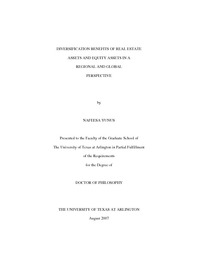
ATTENTION: The works hosted here are being migrated to a new repository that will consolidate resources, improve discoverability, and better show UTA's research impact on the global community. We will update authors as the migration progresses. Please see MavMatrix for more information.
Show simple item record
| dc.contributor.author | Yunus, Nafeesa | en_US |
| dc.date.accessioned | 2007-09-19T21:53:12Z | |
| dc.date.available | 2007-09-19T21:53:12Z | |
| dc.date.issued | 2007-09-19T21:53:12Z | |
| dc.date.submitted | August 2007 | en_US |
| dc.identifier.other | DISS-1845 | en_US |
| dc.identifier.uri | http://hdl.handle.net/10106/635 | |
| dc.description.abstract | The primary purpose of this dissertation is to utilize recently available and reliable high frequency transactions based data provided by FTSE EPRA/NAREIT and employ modern day time series techniques and recently developed diagnostic tests to evaluate the degree of long-run integration and short-run dynamics among major public property markets (in terms of market capitalization) over a period beginning January 2000 and ending March 2006 to evaluate diversification possibilities from the perspective of the US investor. Both Asia and Europe are investigated. A secondary objective is to examine the long-run and short-run interaction among the corresponding major international equity markets to compare and contrast diversification benefits from exploitation of international property markets. Overall, the study provides corroborative evidence that US investors can attain substantial diversification benefits from investing in many of the international property markets in the long-run as well as the short-run. Long-term benefits are available in both the Asian and the European property markets, while greater short-term opportunities are available in the Asia-Pacific markets in the more recent sub-period. The findings also suggest securitized property markets is some countries behave similarly to their corresponding stock markets while others behave in ways that set them apart from the wider equity market (Gordon and Canter, 1999; and Gordon et al. 2001). As hypothesized a-priori, real estate markets show greater signs of (long-run) segmentation or weaker evidence of (long-run) integration (as evidenced by the strength of the relationships among the international property markets) implying that unlike equity markets, US investors can exploit greater opportunities from international portfolio diversification in several of the international property markets in the long-run. Short-run results indicate relatively fewer lead-lag relationships between the US and the international property markets confirming earlier contentions, that due to the underdeveloped state of the securitized property sector (relative to equity markets) and due to the "real estate" nature of these markets, the securitized property sector is less impacted by the US property market in the short run than the corresponding equity markets. | en_US |
| dc.description.sponsorship | Swanson, Peggy | en_US |
| dc.language.iso | EN | en_US |
| dc.publisher | Finance & Real Estate | en_US |
| dc.title | Diversification Benefits Of Real Estate Assets And Equity Assets In A Regional And Global Perspective | en_US |
| dc.type | Ph.D. | en_US |
| dc.contributor.committeeChair | Swanson, Peggy | en_US |
| dc.degree.department | Finance & Real Estate | en_US |
| dc.degree.discipline | Finance & Real Estate | en_US |
| dc.degree.grantor | University of Texas at Arlington | en_US |
| dc.degree.level | doctoral | en_US |
| dc.degree.name | Ph.D. | en_US |
| dc.identifier.externalLink | https://www.uta.edu/ra/real/editprofile.php?onlyview=1&pid=931 | |
| dc.identifier.externalLinkDescription | Link to Research Profiles | |
Files in this item
- Name:
- umi-uta-1845.pdf
- Size:
- 642.6Kb
- Format:
- PDF
This item appears in the following Collection(s)
Show simple item record


